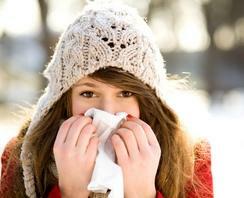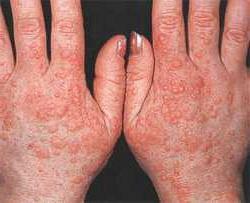 Allergy to cold is one of the negative responses of the human body to certain stimuli coming from outside.
Allergy to cold is one of the negative responses of the human body to certain stimuli coming from outside.
As can be understood from the name, in this case, the external stimulus is cold (often, frosty) air.
The reaction to cold is often observed in people in the age range of 20-50 years. Allergic manifestations can occur not only in winter, but also in summer after being in cold water.
In its symptoms, such an allergic reaction is similar to other types of allergies. Most often occurs on the open parts of the body - hands and face.
Causes
The medicine can not provide the very mechanism of the emergence and development of cold allergy, but the following factors are the reasons for this reaction:
- With a sharp change in the location of a person in a medium with a normal temperature of air in a medium with a low temperature - in the winter, especially in windy weather.
- In contact with cold water - in everyday life when washing dishes, cleaning, swimming in open water.
- When you use very cold drinks and cold food.
Provocative cold allergies can be long-term diseases, which exhaust the body, reduce the level of immunity, disrupt the metabolism - caries, sinusitis, cholecystitis, intestinal dysbacteriosis and helminthic invasion - can deplete the body, after which often there is a cold allergy.
In a strong, tempered organism with a strong immune system, these temperature differences do not cause any reactions. However, in the case of a decrease in protective forces, systemic disorders, serious diseases, violation of metabolic processes in the body, this type of allergy may appear.
Symptoms
Allergy to cold is manifested by such signs:
- whitish, pinkish dense rashes, blisters;
- itching;
- lacrimation;
- nasal congestion;
- cough;
- edema;
- pain in the abdomen, swelling of the tongue and pharynx from cold water.
Symptoms of cold allergies are often compared to a nettle burn, so often this cold is called cold urticaria. What to do, and what to treat such a problem, we will discuss below.
Symptoms of cold allergy
 Allergy to cold is very difficult to diagnose, because its symptoms are not much different from cold symptoms.. And there and there appear snot and tear the eyes.
Allergy to cold is very difficult to diagnose, because its symptoms are not much different from cold symptoms.. And there and there appear snot and tear the eyes.
But there are differences, and the main thing is that with allergies, it starts a strong itch in the nose, ears, throat, and the body temperature does not rise, as with a cold.
Symptoms of cold allergies develop almost immediately after exposure to the skin or mucous low temperature. It can be not only cold winter air, but also cool water (in summer in a pond, in the pool), ice cream. It can even provoke the development of an allergic reaction by washing with cold water.
Most often, an allergy to cold develops on the hands and face, as these are the most exposed areas of the body.
The resulting rash is accompanied by severe itching, burning, has a pink or whitish color.
After a while after eliminating the contact with the allergen, the rashes pass without outside interference. The warming of the surrounding air can accelerate this process.
Let's take a closer look at the common types of allergic reactions to cold.
- Hives in an acute, chronic or recurrent variant. At first itching, then blisters, transforming into red spots of different areas.
- Runny nose. This manifestation is called pseudoallergic rhinitis. It occurs under the influence of cold air.
- Dermatitis - peeling, itching and swelling of the skin in the affected areas. In severe cases, generalized puffiness.
- Pseudoallergic conjunctivitis. It is characterized by reddening of the eyes, lacrimation and itching. But in a warm place these manifestations immediately disappear.
- Erythema- Pain and redness of affected skin areas.
- Migraine. Probably every person, for once in his life, experienced such an effect of cold: when the jaws were very cold, and his head, as if now, would crack. This is a cold migraine.
- Pain in the lumbosacral region. Under the influence of low temperatures in the body, specific immune complexes can be formed, causing inflammation of the roots.
- Difficulty breathing. This symptom occurs if the cold causes a bronchospastic reflex, as a result of which the respiratory tract sharply narrows.
In general, the manifestations of allergy are reduced to the appearance of a rash of white or pink, itching, swelling of the hands and other open areas of the body, which were exposed to cold, the onset of edema on the lips, tongue, throat, headache, runny nose, conjunctivitis, radiculitis.
How to identify the disease?
You can test yourself while at home. This requires a piece of ice, which must be applied to the forearm. If after 10 minutes from the moment of its removal from this area, whitening or reddening of the skin is noted, then the fears of relevance to you of an allergic reaction are groundless.
But if there was edema or blister, this in itself is an alarming symptom indicating a heightened sensitivity your skin, as well as the need to consult a doctor for further diagnosis and appropriate treatment.
In the laboratory, specific proteins can be detected - cold antibodies, cryofibrinogen, cryoglobulins. In some cases, during an exacerbation of cold allergies, hemoglobinuria may appear.
Allergy to cold: photo on hands and face
How does an allergy look like cold on the hands, and also the face you can see on these photos.
Prevention
Unfortunately, we are not able to influence weather conditions, therefore our main task is to reduce their negative impact on the body.
Before you are the basic rules, which you should clearly adhere to:
- Before going out to the cold, you need to apply a thin layer on your face and hands, since it will help to partially protect the exposed skin from the cold.
- Choose clothes made only from natural fabrics. The best option is cotton, which does not cause allergies.
- Beware of severe temperature changes, before you go outside, stand by the open window.
- Cover in the cold and in the strong wind, hands with gloves, and the face with a hood, high collar and a wide scarf.
- Revise your diet, add fatty fish, olive oil, nuts, omega-3 fatty acids.
- Lips smeared with hygienic lipstick.
It is also important in the fight against cold allergy and hardening of the body. It should be in the summer begin to prepare your skin for a drop in temperature.
Treatment of sun allergies
With diagnosed cold allergy, treatment should begin with the maximum cessation of contact of the body with cold media. It is advisable to stop walking in cold weather or cool weather. If you can not avoid being close to the cold, you need to protect your skin as closely as possible on the face, hands and other open parts of the body with warm clothes, and the respiratory tract through breathing through a scarf or other warm cloth.
All of the above measures are necessary to reduce the hypersensitivity of the organism to cryoglobulin. With prolonged absence of this protein in tissues, the sensitivity decreases independently.
In general, treating allergies to cold on the hands or face uncomplicated - you need to avoid the cold, when possible, and take antihistamines drugs that are desirable to be used before exposure to low temperatures to block some histamines. For this, Fenkarol, Suprastin, is widely used. In severe cases Zirtek or Lomilan.
It is worthwhile to understand that effective treatment of cold allergy is currently lacking. All existing medicines remove exclusively manifested symptoms, and the disease itself can not be cured.
In addition, the vast majority of antihistamines have many side effects (kidneys, liver, metabolic processes, nervous system) and that perhaps the most unpleasant thing is that they get very addictive. However, if you still can not do without them, then they should be taken in minimum doses. Before going out, taking antihistamines will prevent allergy symptoms.

How to choose probiotics for the intestine: a list of drugs.

Effective and inexpensive cough syrups for children and adults.

Modern non-steroidal anti-inflammatory drugs.

Review of tablets from the increased pressure of the new generation.
 Antiviral drugs are inexpensive and effective.
Antiviral drugs are inexpensive and effective.



